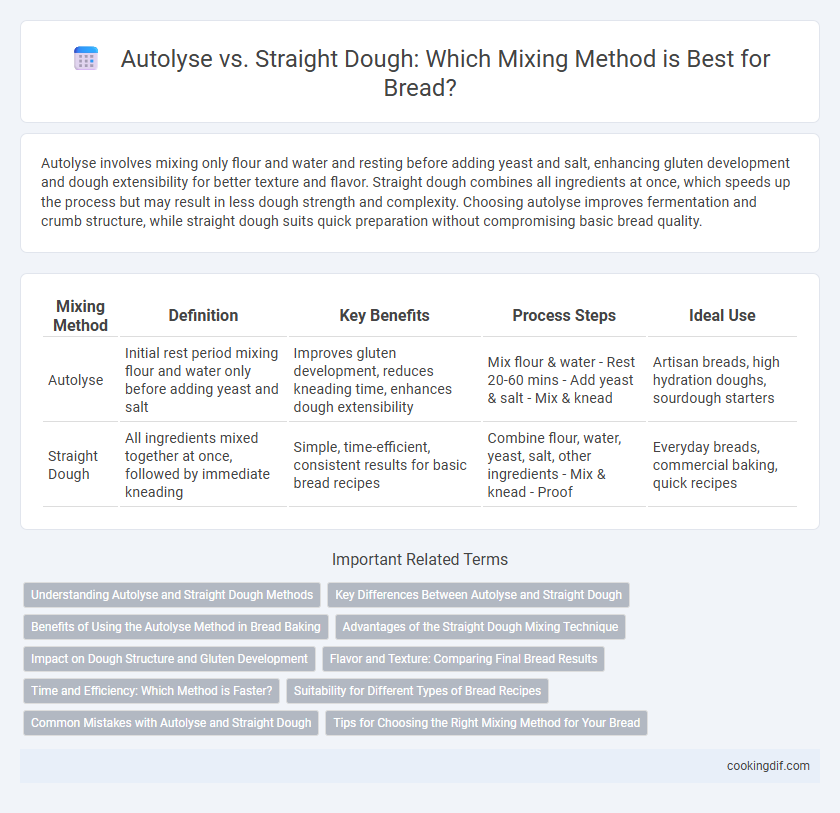Autolyse involves mixing only flour and water and resting before adding yeast and salt, enhancing gluten development and dough extensibility for better texture and flavor. Straight dough combines all ingredients at once, which speeds up the process but may result in less dough strength and complexity. Choosing autolyse improves fermentation and crumb structure, while straight dough suits quick preparation without compromising basic bread quality.
Table of Comparison
| Mixing Method | Definition | Key Benefits | Process Steps | Ideal Use |
|---|---|---|---|---|
| Autolyse | Initial rest period mixing flour and water only before adding yeast and salt | Improves gluten development, reduces kneading time, enhances dough extensibility | Mix flour & water - Rest 20-60 mins - Add yeast & salt - Mix & knead | Artisan breads, high hydration doughs, sourdough starters |
| Straight Dough | All ingredients mixed together at once, followed by immediate kneading | Simple, time-efficient, consistent results for basic bread recipes | Combine flour, water, yeast, salt, other ingredients - Mix & knead - Proof | Everyday breads, commercial baking, quick recipes |
Understanding Autolyse and Straight Dough Methods
Autolyse is a mixing method in bread making that involves combining flour and water and allowing the mixture to rest before adding salt and yeast, enhancing gluten development and improving dough extensibility. Straight dough method mixes all ingredients, including yeast and salt, at once, providing a faster, more straightforward process but potentially less dough strength and flavor complexity. Understanding these methods helps bakers optimize dough texture and fermentation for desired bread quality.
Key Differences Between Autolyse and Straight Dough
Autolyse involves mixing only flour and water initially, allowing enzymes to develop gluten and improve dough extensibility, while straight dough combines all ingredients at once, including yeast and salt. The autolyse method reduces mixing time and enhances dough strength and fermentation, resulting in better texture and flavor. Straight dough offers a faster, simpler process but may produce less extensible dough with a slightly different crumb structure.
Benefits of Using the Autolyse Method in Bread Baking
The autolyse method enhances dough extensibility and fermentation, resulting in improved gluten development and better crumb texture compared to the straight dough method. It reduces kneading time and improves dough hydration, which promotes superior gas retention and oven spring. Bakers benefit from stronger flavor development and a more open crumb structure by allowing flour hydration before adding yeast and salt.
Advantages of the Straight Dough Mixing Technique
The straight dough mixing technique allows for precise control over ingredient incorporation, resulting in consistent dough texture and strength. This method simplifies the process by combining all ingredients at once, reducing preparation time and minimizing potential errors. Bakers benefit from enhanced fermentation control and improved flavor development due to the uniform distribution of yeast and salt.
Impact on Dough Structure and Gluten Development
Autolyse method enhances gluten development by allowing enzymes to break down starches and proteins before mixing, resulting in a more extensible dough with improved gas retention. Straight dough method mixes all ingredients simultaneously, which can lead to a denser gluten network and less extensible dough. Autolyse improves dough structure by promoting better hydration and reducing mixing time, leading to increased loaf volume and crust texture.
Flavor and Texture: Comparing Final Bread Results
Autolyse method enhances flavor development by allowing enzymes to break down starches into sugars, resulting in a more complex taste and improved crumb texture with greater extensibility. Straight dough mixing incorporates all ingredients simultaneously, producing a quicker fermentation but sometimes leading to a denser crumb and less nuanced flavor profile. Bakers seeking a softer, airier texture and richer aroma often prefer autolyse, while straight dough suits faster production with consistent but simpler bread characteristics.
Time and Efficiency: Which Method is Faster?
Autolyse method reduces overall mixing time by allowing flour and water to hydrate before adding yeast and salt, enhancing dough extensibility and fermentation efficiency. Straight dough method combines all ingredients at once, resulting in longer mixing time and kneading to develop gluten structure fully. Autolyse is generally faster and more efficient, optimizing dough consistency with less mechanical effort and improving baking workflow.
Suitability for Different Types of Bread Recipes
Autolyse mixing method enhances gluten development and hydration, making it ideal for artisan breads like sourdough and baguettes that require extended fermentation. Straight dough technique suits quick bread recipes and enriched doughs, such as sandwich loaves and sweet breads, where ingredients are mixed and baked in a shorter timeframe. Understanding the compatibility of these methods with specific bread types improves texture, crumb structure, and overall baking efficiency.
Common Mistakes with Autolyse and Straight Dough
Common mistakes with autolyse include overhydration that weakens gluten development and insufficient mixing after the rest period, reducing dough elasticity. In straight dough, errors often involve uneven ingredient distribution and underdeveloped gluten due to rushed mixing. Both methods demand precise hydration and thorough mixing to ensure optimal dough structure and bread quality.
Tips for Choosing the Right Mixing Method for Your Bread
Autolyse improves dough extensibility by resting flour and water before adding yeast and salt, enhancing gluten development and flavor complexity in artisan breads. Straight dough mixing enables faster preparation and better yeast activation, ideal for softer, enriched breads or quick baking schedules. Choose autolyse for rustic or sourdough recipes requiring strong gluten structure, while straight dough suits enriched doughs or time-sensitive baking.
Autolyse vs Straight Dough for mixing method Infographic

 cookingdif.com
cookingdif.com